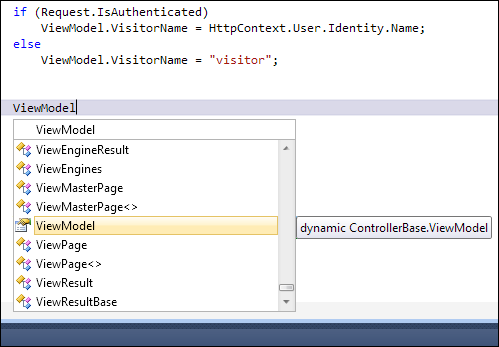ASP.NET MVC 3: New ViewModel is dynamic ViewData
ASP.NET MVC 3 introduces new ViewModel property of Controller that you can use to assign different properties to the model of your view. ViewModel is dynamic by type. In this posting I will show you how to use ViewModel property in your ASP.NET MVC applications.
Suppose you have controller for products that has method Details() to show details of product requested by visitor. We want to use dynamic ViewModel to get data to details view.

So, here is our controller that uses dynamic ViewModel.
public ActionResult Details(int productId)
{
var product = _repository.GetProductById(productId);
if (Request.IsAuthenticated)
ViewModel.VisitorName = HttpContext.User.Identity.Name;
else
ViewModel.VisitorName = "visitor";
ViewModel.ProductName = product.Name;
ViewModel.ProductUnitPrice = product.UnitPrice;
ViewModel.ProductDescription = product.Description;
// ...
return View();
}
And here is the fragment of view that shows product details.
<h2><%= ViewModel.ProductName %> (<%= ViewModel.ProductPrice %> EUR)</h2>
<p>
<%= ViewModel.ProductDescription %>
</p>
User can see besides other stuff the fragment like this.

Let’s try now what happens when we use good old ViewData instead of ViewModel.
public ActionResult Details(int productId)
{
var product = _repository.GetProductById(productId);
if (Request.IsAuthenticated)
ViewData["VisitorName"] = HttpContext.User.Identity.Name;
else
ViewData["VisitorName"] = "visitor";
ViewData["ProductName"] = product.Name;
ViewData["ProductUnitPrice"] = product.UnitPrice;
ViewData["ProductDescription"] = product.Description;
// ...
return View();
}
Don’t make any other changes to code. Compile your project and refresh product page. Guess what … the result is same as before! Why should ViewData and ViewModel be synchronized? Think about controller unit test and it should be clear.
Conclusion
ViewModel property of Controller is great addition to ASP.NET MVC and it makes our code and views more readable. Instead of using ViewData or strongly typed views we can use ViewModel to form our model objects dynamically and give them to views.




Hey gunnarpeipman… Thanks to explain about this cool property………..
Nice, but these days you should be using <%: instead of <%= :)
Really cool article for ViewData and ViewModel difference.
I don’t like the use of ViewData at all.
1) You don’t define what is required.
2) No compile time errors
I create a class now i.e. ProductViewModel
public class ProductViewModel{
public Product Product {get; set;}
public decimal Price {get; set;}
}
And send this as my view to the model.
Got this from the NerdDinner sample chapter by ScottGu
Thanks! The light just went on!
The justification at end is wrong. You cannot always replace strong types with dynamic types and inherit all drawbacks of dynamic programming like performance overhead, intellisense missing etc. It should be used only when dynamic programming makes sense. Given that all code is within our control (and within managed world) we should mostly use correct patterns (like dynamic polymorphism with interfaces) and replace it with dynamic programming. Always remember that Dynamic programming should be the last resort not the first.
@Rahul. “Dynamic programming should be the last resort not the first”??? Dynamic programming should and probably will be used far more than it is today by most msft devs. It sounds to me like you have gotten the wrong impression of dynamic programming.